 Thank you for visiting HOJO website. If you have any enquiry, please feel free to get in touch with us at
Thank you for visiting HOJO website. If you have any enquiry, please feel free to get in touch with us at
▼ Akira Hojo
▼ Hojo Newsletter
▼ HOJO FACEBOOK





HOME > Black Tea > Keemun Black Tea: 祁門紅茶
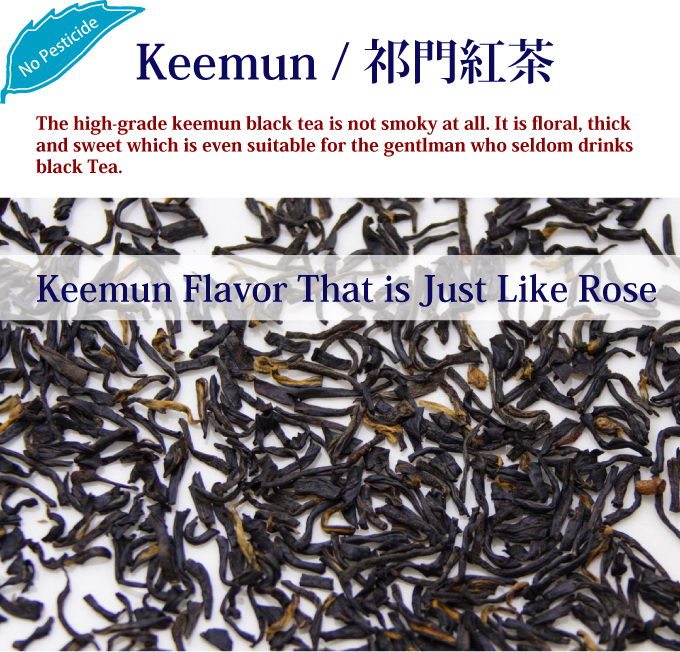
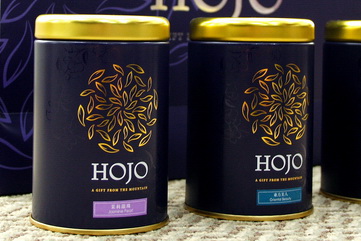


Keemun is a historical reputed black tea in China. It was produced during Qing Dynasty at the Keemun County (祁门县 Qi-men Xian) and surrounding areas at Anhui Province (安徽省 An-hui Sheng). It was said that Keemun was produced as taking the inspiration of the famous black tea in Fujian, which was said to be the Lapsang Souchong.
In the past, Keemun was mainly exported and highly appreciated by people in oversea, especially Britain and United State. The tea leaf is slender and fine, giving the sugary flavor with scent of sweet flowery note, with thick and mellow taste. These distinctive cup characteristics have gained much attention in the international tea profession. During year 1939-1940, the price of Keemun at the New York trade centre recorded the highest figure; it was the most expensive tea at that time and only upper class in the society could afford it. The Imperial and Noble Family used to treat it as a fashionable beverage. It was said that Keemun was presented to Queen Victoria as the Gift Tea during Her birthday. In US, it was the everyday-tea for the President of United State, Mr. Roosevelt and his spouse. Up to date, it is one of the three major black teas in the world, i.e., Darjeeling Tea from India and Uva Black Tea from Sri Lanka.
HOJO particularly focus on Keemun from the original production area, i.e., Qi-men area which is located at the province nature preserved park at Anhui Province. The genuine cultivar is 槠叶种 (Zhu-ye-zhong). There are many other cultivars being used to produce Keemun. However, different cultivars at other growing environment and difference kind of manufacturing know-how makes them different quality from the original Keemun that is produced from Qi-men area. In addition, we choose no-pesticide tea as our own standard.
The tea garden is scattered at the mountainous area which covered by forest. At this area, there is sufficient rainfall and the atmospheric temperature is lower with higher humidity. One of the essential factors for good black tea is mellow taste. This taste is originated from amino acid found in tea leaf, named as theanine. Young buds contains high level of theanine and when tea leaves receive sun light, theanine is converted to polyphenol such as catechins. At high elevation, the area is often covered by fog which blocks the direct sun light on tea leaves. Consequently, tea leaves are very rich in theanine as the conversion to polyphenol is not effectively taking place. This is the foundation for the Keemun with long-lasting fragrance and non-astringent but mellow taste.
Keemun was made in year 1875 at Keemun County (祁门县 Qi-men Xian) at Anhui Province (安徽省 An-hui Sheng). During the early stage of Qing Dynasty, the Keemun County was famous in producing green tea. In the beginning of Qing Dynasty, the process of black tea was developed in Fujian Province. The increase popularity of black tea in oversea market caused the bloom of black tea production in Anhui Province. Due to its high profit margin, the tea merchant started to influence the farmer to involve in the production of black tea. It was mainly exported and Britain was one of its main importers besides France, US, German, etc. Once upon a time (1939-1940), Keemun recorded the highest selling price at the wholesale market at New York City as compared to other famous black tea, e.g., India, Ceylon black tea.
Keemun Black Tea gives fresh sweet sugary flavor with scent of flowery note; its long-lasting aromatic flavor had gained much attention. Up to date, it enjoys equal popularity and fame as Darjeeling Tea from India and Uva Black Tea from Sri Lanka. The Imperial and Noble Family used to treat it as a fashionable beverage and presented it as a Gift Tea during special occasion.
Keemun Black Tea has been awarded for many times at international and domestic tea contest. The main awards are:
1913: Keemun Black Tea was awarded the Gold Prize at the Expo held at Italy
1915: It won the Gold Prize during the Expo (万国博览会) held at Panama
1987: During the 26th World Premium Food Product Contest held at Belgium, Keemun has won the gold prize.
1988: Keemun was awarded the gold prize during the 1st Food Expo in China.
Leaf is thin and slender, tightly rolled, with sharp point and containing buds. If poor quality, the leaf is loose, thick and coarse, without the sharp point and not containing bud.
Leaf in dark black color (乌润 Wu-run). It looks glossy and luster. For poor quality, the leaf is grayish black color, dull appearance with brownish color.
The good quality tea consist pieces of leaf of fairly even size. If the tea is of poor quality, the leaf is mixed with lots of bold leaf which is flat, loose and large size. This is made from old leaf which contains high level of fiber that could hardly rolled into tight strip during the process. These leaves give thinner taste and lighter color when brew. Besides, poor quality tea contains much broken pieces which are light in weight. This is due to the improper handling and the finished product is not well sifted.
The well-made tea must be free from extraneous matter such as fiber, bamboo or wooden flakes, sand or stone, dust. Stalk is unavoidable as the leaf is plucked during summer, but must be at minimal level, e.g. a few pieces per gram.
Dry leaf gives sugar syrup flavor with mild smoky flavor. When brewed, the liquor gives the same aromatic profile. After brewing, the aroma remains on the leaf of good Keemun.
When brewed, the tea produces liquor with luster and bright reddish brown color. In a cup, the good Keemun gives bright golden ring appeared near the edge of liquor to the cup. The golden ring is the sign that tea leaves are rich in theaflavins that is vital for good quality. For poor quality, the color is dark red with dull appearance.
Smooth, brisk with mild green refreshing note. It is different from the commercial versions of this famous tea which is often giving harsh astringency or roughness, or thin and flat taste.
The brewed leaves show bright brownish red color, very consistent and even over the leaf, indicating good quality and well-made tea. When touched with finger, the leaves are thick, soft and elastic. If the tea is of poor quality, leaves are mixture of greenish brown and red color. When touched, the leaf is very thin but stiff, with very thick and coarse leaf vein. Besides, the green color spot is found on surface of leaf indicating insufficient oxidation. The leaf looks dull and lack of brightness, and in dark color.
Use soft water for preparation of tea. It is suitable to effectively extract most of the substances from tea leaf. Hard water is sometimes makes after taste very strong. But it obviously reduce flavor. Use fresh water which has not boiled before. Bring the cold water to boil.Beforehand, it is important to warm the teapot well by rinsing it out with boiled water. This should be done just before adding the tea leaves, so that leaves benefit from a gentle humid heat.
Go to further information about suitable water for brewing tea >>
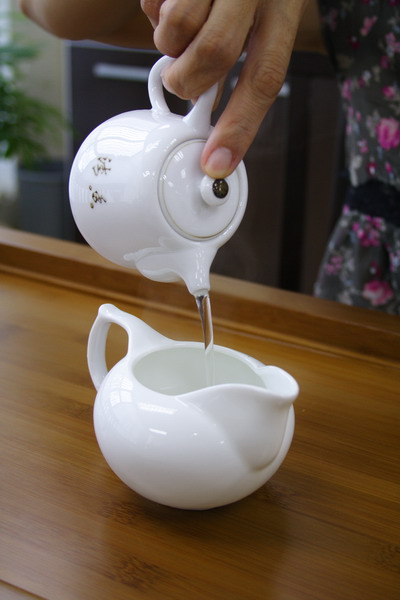
Warm up the pitcher
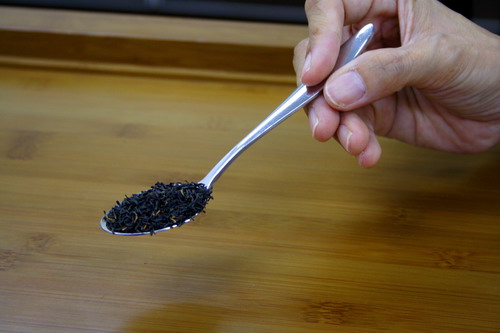
3g for 150ml of water. 2 Tea spoons = 3g
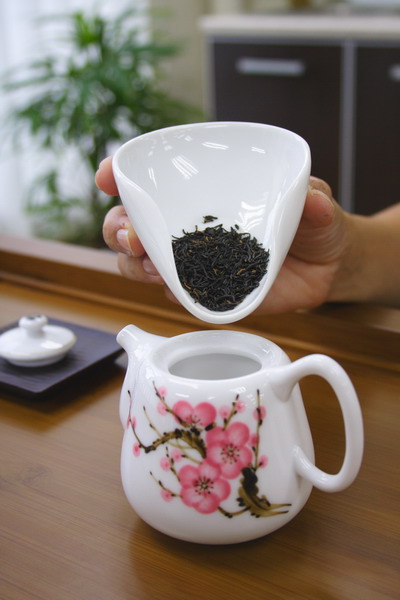
Pour the tea leaves into the warmed tea pot.

If you do not have tea pot and use any container for brewing tea, please make sure use a cap in order not to reduce the temperature.
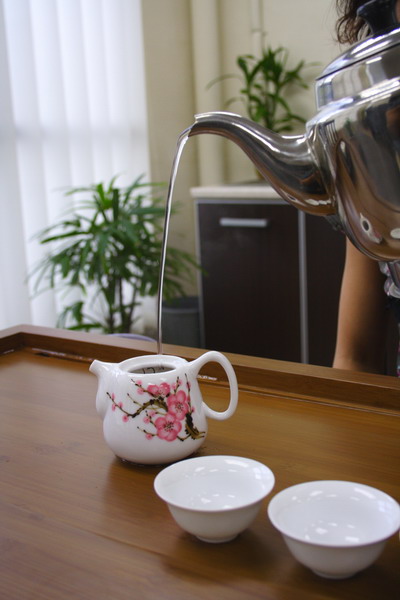
It is not advisable to pour water from high position. It would damage the tea leaf and cause astringent taste.
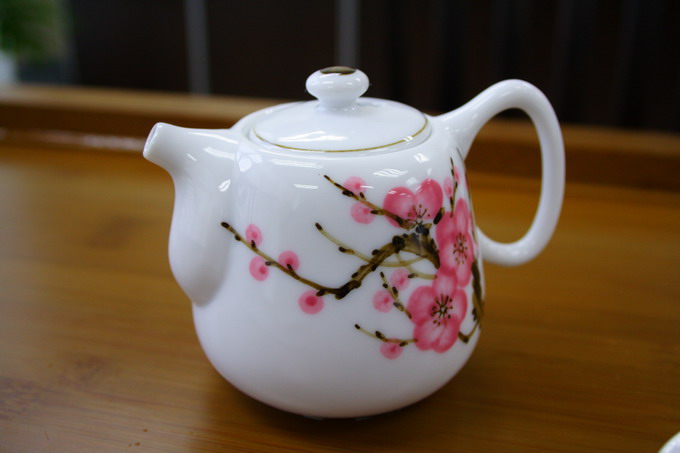
Brew for 1-2 mins. 1 min for lighter taste and 2 mins for thicker taste.
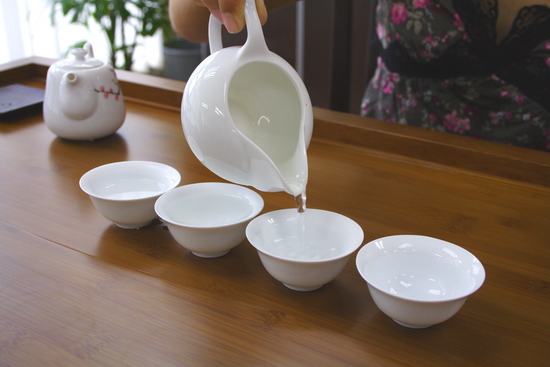
If you prefer tea to be very hot, please warm up the tea cup in advane.
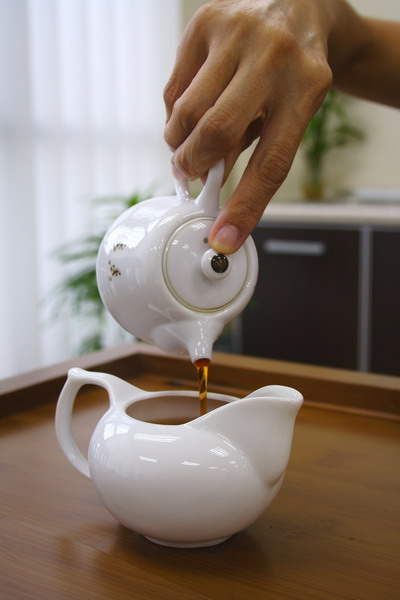
Move tea into pithcer in order to even out its concentration.
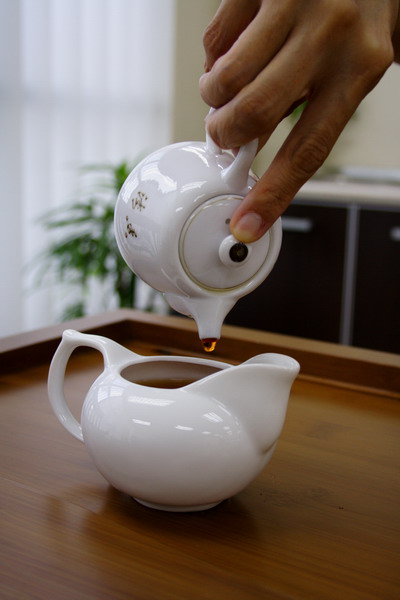
After 1st brewing, tea leaves must be filtered well and kept without water. This is to avoid the liquor becoming bitter and stewed, and also to avoid unpleasant feeling of bits of tea leaves on your palate when drinking. Besides, it prevents tea leaves from being over cooked.
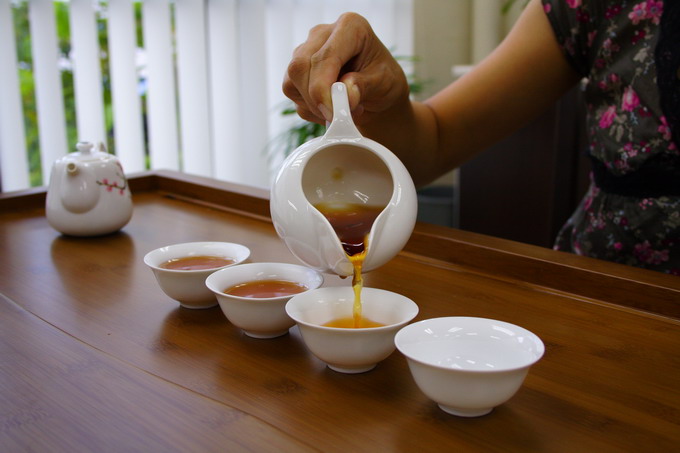
In the tradition, the tea cup on the right is meant for the guest or someone who is the most superior.
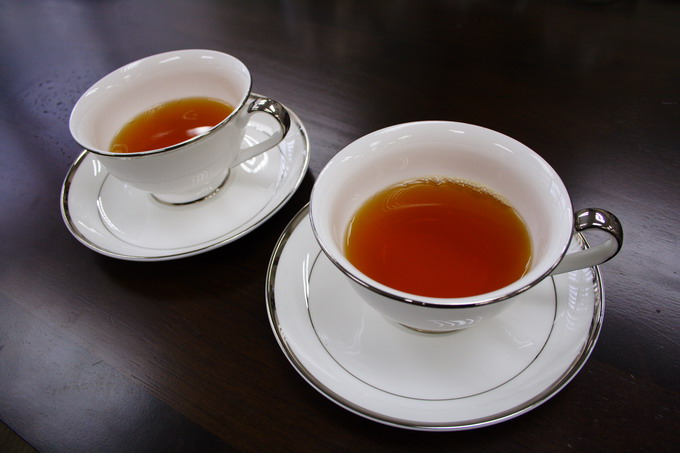
Beside using Chinese style tea cup, it is also suitable to use English tea cup.
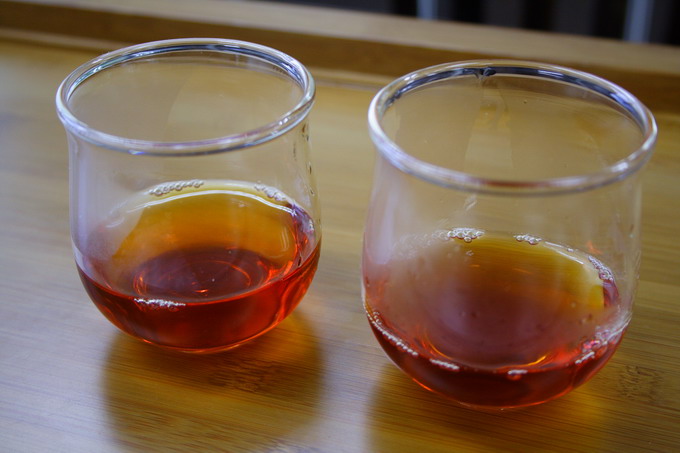

is the tea that started the boom of black tea demand in England. Why had this tea impressed the English? In England, it is known that water there is very hard. (Not all the area though). When using hard water to brew black tea, the mineral form the complex with the constituent of tea such as poly phenol and tannin. Once they form a complex, it seriously affects its taste. In general, the taste becomes flat and bitter.
We have conducted an experiment brewing Keemun Black Tea using hard and soft water and taste them in straight and with milk.
Having it straight, tea brewed in hard water gives a less smoky aroma which was much easier to drink, yet taste became thinner. On the contrary, with milk, we felt that hard water brewed tea was much easier to drink. The taste and aroma was well balanced. In conclusion, we found that hard water is an excellent choice for brewing Keemun Black Tea.
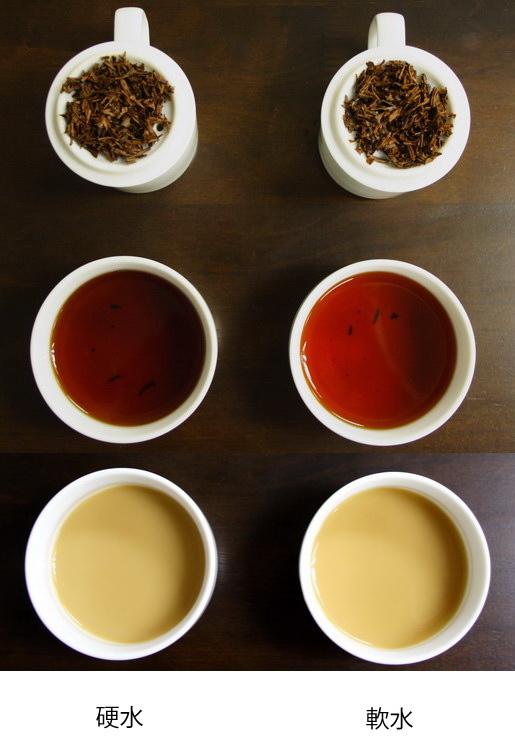

Please feel free to send us e-mail for enquiry at:

 |
We accept various kinds of credit card through Paypal.
Only if customer prefer other option of payment, we suggest "Bank Transfer".
Various choice of shipping method
EMS, SAL, Small Packet, Small Packet (SAL) Yamato Express and Surface
For shipping tea, we usually suggest small air parcel, the estimated shipping cost of tea in 100g (with wrapping material ) is
Small Parcel
USA JPY 600, EU JPY600 and Asia JPY470
Small Packet (SAL)
USA JPY380, EU JPY380 and Asia JPY320
The shipping fee to oversea by small air parcel happens to be even cheaper than domestic shipping fee in Japan.
For your information, some countries, EU in particular imposes custom duty. We need buyer to bare the duty. We are sorry, but we cannot change the amount on the invoice, and we do not mark any packages as gifts. We will strictly follow the custom regulation.